三年级-肯定句改否定句和一般疑问句
- 格式:pdf
- 大小:8.85 KB
- 文档页数:2
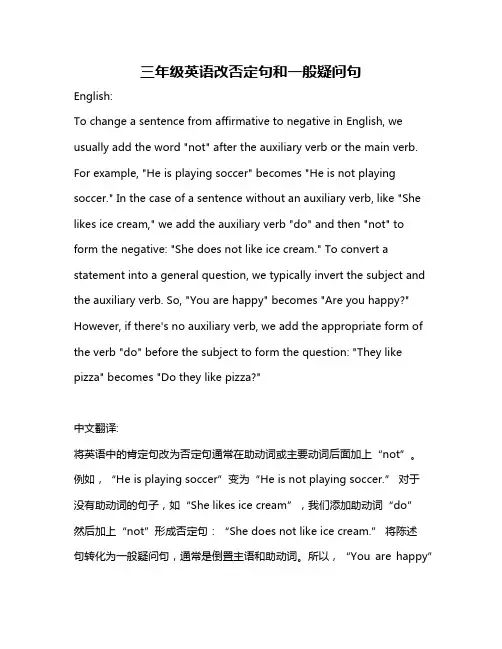
三年级英语改否定句和一般疑问句English:To change a sentence from affirmative to negative in English, we usually add the word "not" after the auxiliary verb or the main verb. For example, "He is playing soccer" becomes "He is not playing soccer." In the case of a sentence without an auxiliary verb, like "She likes ice cream," we add the auxiliary verb "do" and then "not" to form the negative: "She does not like ice cream." To convert a statement into a general question, we typically invert the subject and the auxiliary verb. So, "You are happy" becomes "Are you happy?" However, if there's no auxiliary verb, we add the appropriate form of the verb "do" before the subject to form the question: "They like pizza" becomes "Do they like pizza?"中文翻译:将英语中的肯定句改为否定句通常在助动词或主要动词后面加上“not”。
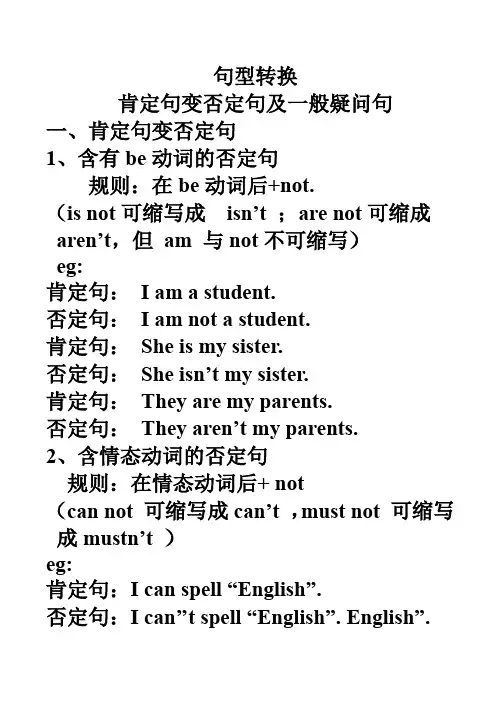
句型转换肯定句变否定句及一般疑问句一、肯定句变否定句1、含有be动词的否定句规则:在be动词后+not.(is not可缩写成isn’t ;are not可缩成aren’t,但am 与not不可缩写)eg:肯定句:I am a student.否定句:I am not a student.肯定句:She is my sister.否定句:She isn’t my sister.肯定句:They are my parents.否定句:They aren’t my parents.2、含情态动词的否定句规则:在情态动词后+ not(can not 可缩写成can’t ,must not 可缩写成mustn’t )eg:肯定句:I can spell “English”.否定句:I can’’t spell “English”.English”.肯定句:I must find it.否定句:I mustn’t find it.3、含有实义动词的句子的否定句构成(1)第三人称单数做主语。
(he、she、it或表示单个人或物的第三人称名词)规则:要在行为动词前加上助动词doesn’t,然后将动词恢复原形。
eg :肯定句:He has a soccer ball.否定句:He doesn’t have a soccer ball.(2)其它人称做主语规则:在行为动词前加don’t ,句子中的行为动词用原形。
eg:肯定句:They like bananas.否定句:They don’t like bananas.注:(1)在变否定句时,如遇some应变any Here are some books.Here aren’t any books.二、肯定句变一般疑问句1、含有be动词的句子变一般疑问句规则:把be动词提至句首,第一人称变第二人称,句末句号变问号。
(I/we变成youMy/our变成your)肯定句:I am a student.一般疑问句:Are you a student?肯定句:She is my sister.一般疑问句:Is she your sister?肯定句:They are my parents.一般疑问句:Are they your parents?2、含有情态动词的句子变一般疑问句规则:把情态动词提至句首,第一人称变第二人称,句末句号变问号。
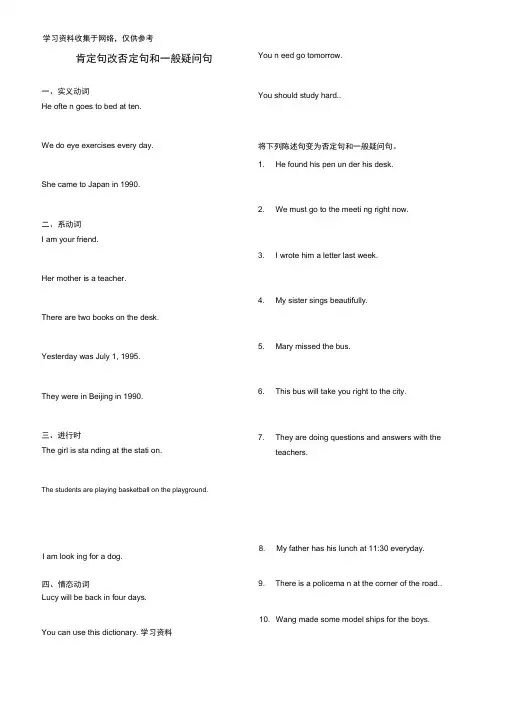
肯定句改否定句和一般疑问句一、实义动词He ofte n goes to bed at ten.We do eye exercises every day.She came to Japan in 1990.二、系动词I am your friend.Her mother is a teacher.There are two books on the desk.Yesterday was July 1, 1995.They were in Beijing in 1990.三、进行时The girl is sta nding at the stati on.The students are playing basketball on the playground. You n eed go tomorrow.You should study hard..将下列陈述句变为否定句和一般疑问句。
1. He found his pen un der his desk.2. We must go to the meeti ng right now.3. I wrote him a letter last week.4. My sister sings beautifully.5. Mary missed the bus.6. This bus will take you right to the city.7. They are doing questions and answers with theteachers.8. My father has his lunch at 11:30 everyday.四、情态动词Lucy will be back in four days.9. There is a policema n at the corner of the road..10. Wang made some model ships for the boys. You can use this dictionary. 学习资料I am look ing for a dog.24. I can go to the zoo today.11. I saw somebody in the room just now.12. There is some wonderful news in today ' paper.13. Xiao Li dropped the letter into the letter box.14. They are playing on the playground.15. Tom often tells them stories in French.16. After class some students play balls.17. Mary is reading newspaper now.18. I telephoned you yesterday.19. You have to go now.20. I have a house in the country.21. We did our homework together.22. They study for exam in ation.23. We are talking about the film. 25. The first class beg ins at eight o 'clock.26. It takes you three hours to go to Paris by air.27. I reviewed my lessons yesterday.28. I ilgo home by bus.29. He forgot to post the letter this morning.30. This room is going to be pain ted n ext week.肯定句变否定句和一般疑问句类型答案一、实义动词He ofte n goes to bed at ten.T He does not ofte n go to bed at ten.T Does he ofte n go to bed at ten?We do eye exercises every day.T We don' t do eye exercises every day.T Do you do eye exercises every day?She came to Japan in 1990.T She did not come to Japa n in 1990.T Did she come to Jap an in 1990?二、系动词I am your friend.T I am not your friend.T Are you my friend?Her mother is a teacher.T Her mother is not a teacherT is her mother a teacher?There are two books on the desk.T There are not two books on the deskT Are there two books on the desk?Yesterday was July 1, 1995.T Yesterday was not July 1, 1995.T Was yesterday July 1, 1995?They were in Beijing in 1990.T They were not in Beijing in 1990T Were they in Beiji ng in 1990?三、进行时The girl is sta nding at the stati on.T The girl is not sta nding at the stati on.T is the girl sta nding at the stati on?The students are playing basketball on the playground.T The students are not playing basketball on the playgro und.T Are the students playing basketball on theplaygro und?I am look ing for a dog.T I am not look ing for a dog.T Are you look ing for a dog?He was writing letters at this time last night.T He was not writing letters at this time last night.T Was he writing letters at this time last night? We were hav ing a meet ing this time yesterday. T We were n ot hav ing a meet ing this time yesterday. T Were you havi ng a meet ing this time yesterday? 四、情态动词Lucy will be back in four days.T Lucy will not be back in four days.T Will Lucy be back in four days?You can use this dict ion ary.T You can not use this dict ion ary.T Can I use this dict ion ary?You n eed go tomorrow.T You n eed not go tomorrow.T Need I go tomorrow?You should study hard.T You should not study hard..T should I study hard ?将下列陈述句变为否定句和一般疑问句。
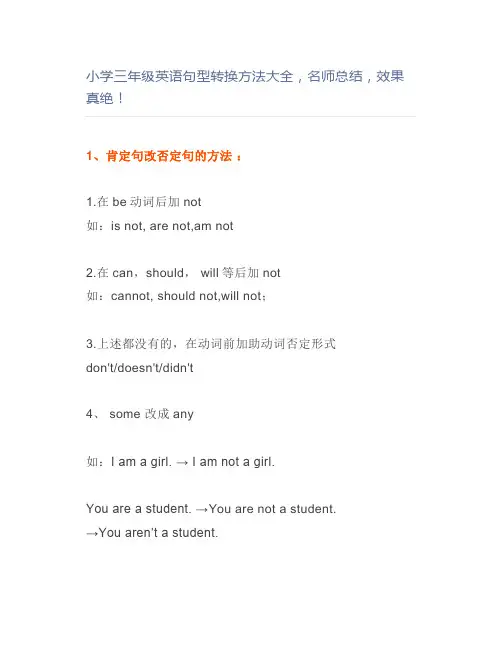
小学三年级英语句型转换方法大全,名师总结,效果真绝!1、肯定句改否定句的方法:1.在be动词后加not如:is not, are not,am not2.在can,should, will等后加not如:cannot, should not,will not;3.上述都没有的,在动词前加助动词否定形式don't/doesn't/didn't4、 some 改成any如:I am a girl. → I am not a girl.You are a student. →You are not a student.→You aren’t a student.This is Tom’s bag, → This is not Tom’s bag.→ This isn’t Tom’s bag.2、肯定句改一般疑问句的方法1.把be动词放在句首,剩下的照抄(some 改成any,I改成you,my改成your)句点改成问号。
2.把can,shall, will等放到句首,剩下的照抄(some 改成any,I改成you,my改成your)句点改成问号。
3.上述都没有的,在句首请助动词Do/Does/Did帮忙,剩下的照抄,(some 改成any,I改成you,my改成your,)句点改成问号注意:句首的第一个字母要大写,句尾标点应为“?”如:I am in Class 6. →Are you in Class 6?You are from America.→Are you from America?It is an orange. →Is it an orange?4、就一般疑问句回答一般疑问句有两种回答,即:肯定回答和否定回答。
其中,肯定回答用yes,否定回答用no。
语句顺序为:Yes + 主语 + am /is/ are/was/were.|can.|do/does/did|; No + 主语+ am not/ isn’t/ aren’t 如:—Are you an English teacher?→Yes, I am. /No, I am not.—Is that a bird?→Yes, it is./ No, it isn’t.3、对划线部分提问“就划线部分提问”是小学阶段英语学习的难点,但是一旦掌握了规律,就变得容易多了。
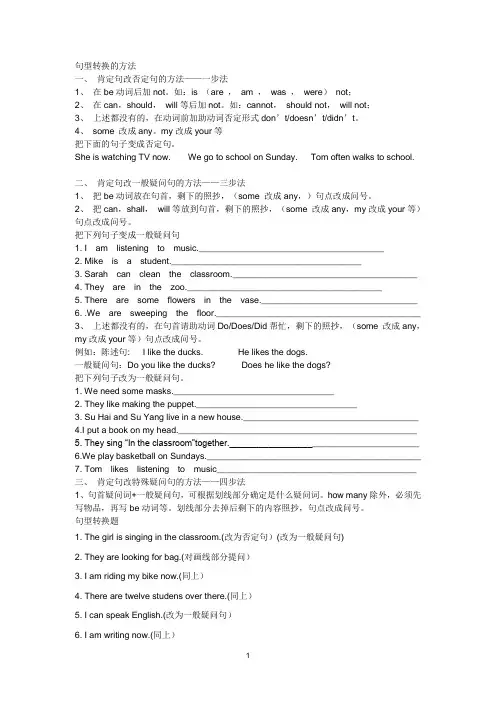
句型转换的方法一、肯定句改否定句的方法——一步法1、在be动词后加not。
如:is (are ,am ,was ,were)not;2、在can,should,will等后加not。
如:cannot,should not,will not;3、上述都没有的,在动词前加助动词否定形式don’t/doesn’t/didn’t。
4、some 改成any。
my改成your等把下面的句子变成否定句。
She is watching TV now. We go to school on Sunday. Tom often walks to school.二、肯定句改一般疑问句的方法——三步法1、把be动词放在句首,剩下的照抄,(some 改成any,)句点改成问号。
2、把can,shall,will等放到句首,剩下的照抄,(some 改成any,my改成your等)句点改成问号。
把下列句子变成一般疑问句1. I am listening to music.______________________________________2. Mike is a student._______________________________________3. Sarah can clean the classroom.______________________________________4. They are in the zoo.________________________________________5. There are some flowers in the vase.________________________________6. .We are sweeping the floor.__________________________________________ 3、上述都没有的,在句首请助动词Do/Does/Did帮忙,剩下的照抄,(some 改成any,my改成your等)句点改成问号。
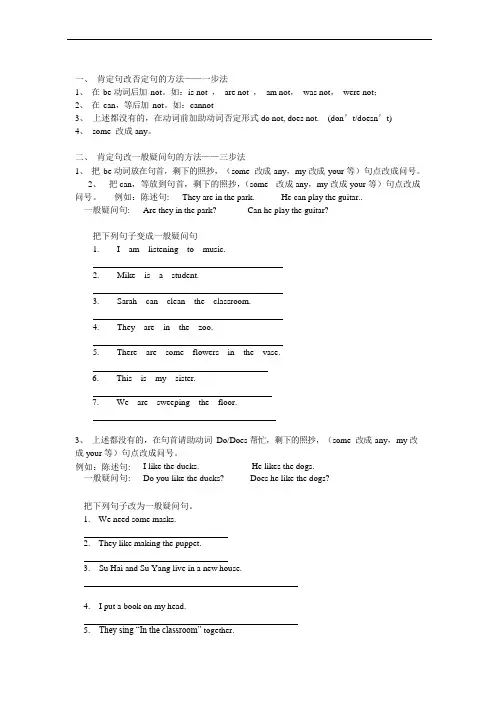
一、肯定句改否定句的方法——一步法1、在be 动词后加not。
如:is not ,are not ,am not,was not,were not;2、在can,等后加not。
如:cannot3、上述都没有的,在动词前加助动词否定形式do not, does not. (don’t/doesn’t)4、some 改成any。
二、肯定句改一般疑问句的方法——三步法1、把be 动词放在句首,剩下的照抄,(some 改成any,my 改成your 等)句点改成问号。
2、把can,等放到句首,剩下的照抄,(some 改成any,my 改成your 等)句点改成问号。
例如:陈述句: They are in the park. He can play the guitar..一般疑问句: Are they in the park? Can he play the guitar?把下列句子变成一般疑问句1. I am listening to music.2. Mike is a student.3. Sarah can clean the classroom.4. They are in the zoo.5. There are some flowers in the vase.6.This is my sister.7.We are sweeping the floor.3、上述都没有的,在句首请助动词Do/Does 帮忙,剩下的照抄,(some 改成any,my 改成your 等)句点改成问号。
例如:陈述句: I like the ducks. He likes the dogs.一般疑问句: Do you like the ducks? Does he like the dogs?把下列句子改为一般疑问句。
1.We need some masks.2.They like making the puppet.3.Su Hai and Su Yang live in a new house.4.I put a book on my head.5.They sing “In the classroom” together.6.We play basketball on Sundays.7.Tom likes listening to music三、肯定句改特殊疑问句的方法——四步法1、在一般疑问句的基础上,句首添加一个疑问词即可,可根据划线部分确定是什么疑问词。
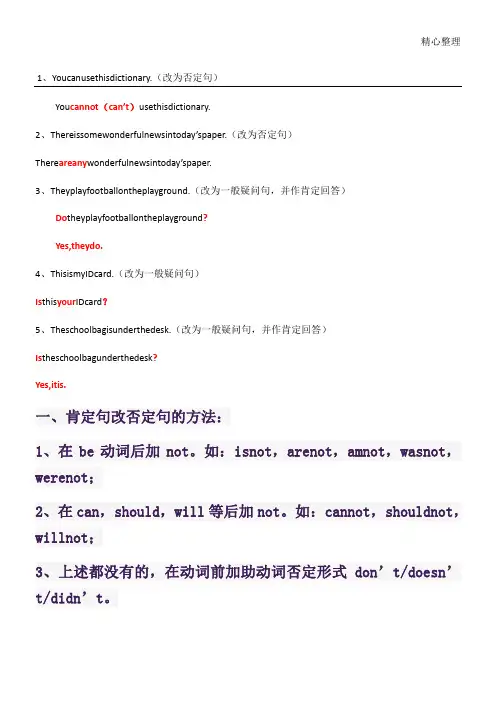
精心整理1、Youcanusethisdictionary.(改为否定句)You cannot(can’t)usethisdictionary.2、Thereissomewonderfulnewsintoday’spaper.(改为否定句)There areany wonderfulnewsintoday’spaper.willnot;3、上述都没有的,在动词前加助动词否定形式don’t/doesn’t/didn’t。
4、some改成any。
如:Iamagirl.→Iamnotagirl.Youareastudent.→Youarenotastudent.→Youaren’tastudent.抄,(some改成any,I改成you,my改成your,)句点改成问号。
注意:句首的第一个字母要大写,句尾标点应为“?”。
如:IaminClass6.→AreyouinClass6?YouarefromAmerica.→Areyoufrom America?Itisanorange.→Isitanorange?答题方法是:要想提问,be提前,句末“?”别忘了。
4、就一般疑问句回答一代:用正确的疑问词代替划线部分。
二移:把疑问词移至句首三倒:颠倒主谓语,但对主语或其定语提问时除外(some改成any,I改成you,my改成your),四抄:照抄句子剩余部分。
☆总结关键就是:“特殊疑问词+一般疑问句”(即:先根据划线部分找到特殊疑问词;再把没划线的部分变成一般疑问句的语序。
)4、划线部分是“时间”,特殊疑问词用whattime或when5、划线部分是“年龄”,特殊疑问词用howold6、划线部分是“职业”,特殊疑问词用what殊疑问词用whose以下口诀要牢记:1.问“谁”用who;2.问“谁的”,用whose;3.问“地点哪里”,用where;13.问“颜色”,用whatcolour;14.问“星期”,用whatday;15.问什么学科,用whatsubject;16.问“什么时候”,用when;17.问几点用What’sthetime?或Whattimeisit?四、同义句型转换同义句型转换,是把意思相同或相近的句子用不同的词汇、短语及句型表示出来。
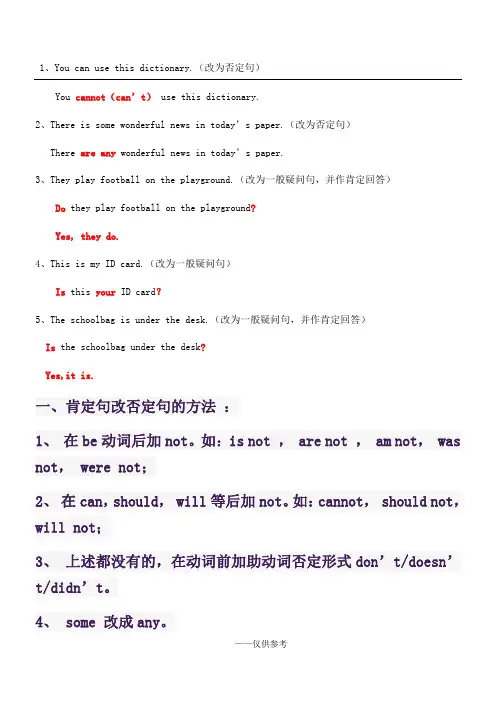
1、You can use this dictionary.(改为否定句)You cannot(can’t) use this dictionary.2、There is some wonderful news in today’s paper.(改为否定句)There are any wonderful news in today’s paper.3、They play football on the playground.(改为一般疑问句,并作肯定回答)will not;3、上述都没有的,在动词前加助动词否定形式don’t/doesn’t/didn’t。
4、 some 改成any。
如: I am a girl. → I am not a girl.You are a student. →You are not a student.→You aren’t a student.This is Tom’s bag, → This is not Tom’s bag.注意:句首的第一个字母要大写,句尾标点应为“?”。
如:I am in Class 6. →Are you in Class 6?You are from America. →Are you from??America?It is an orange. →Is it an orange?答题方法是:要想提问,be提前,句末“?”别忘了。
4、就一般疑问句回答一般疑问句有两种回答,即:肯定回答和否定回答。
其中,肯定二移:把疑问词移至句首三倒:颠倒主谓语,但对主语或其定语提问时除外(some 改成any,I改成you,my改成your),四抄:照抄句子剩余部分。
☆总结关键就是:“特殊疑问词+一般疑问句”(即:先根据划线部分找到特殊疑问词;再把没划线的部分变成一般疑问句的语序。
)4、划线部分是“时间”,特殊疑问词用what time或when5、划线部分是“年龄”,特殊疑问词用how old6、划线部分是“职业”,特殊疑问词用whatthat ?以下口诀要牢记:1.问“谁”用who;2.问“谁的”,用whose;3.问“地点哪里”,用where;13.问“颜色”,用what colour;14.问“星期”,用what day;15.问什么学科,用what subject;16.问“什么时候”,用when;17.问几点用What’s the time?或 What time is it?四、同义句型转换同义句型转换,是把意思相同或相近的句子用不同的词汇、短语及句型表示出来。
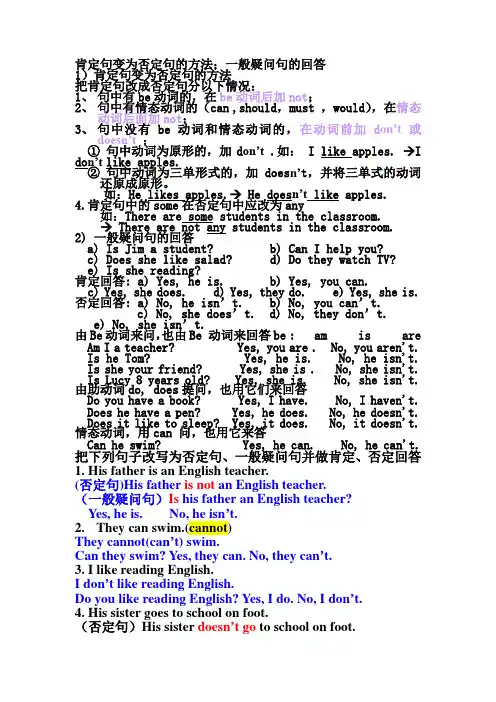
肯定句变为否定句的方法;一般疑问句的回答1)肯定句变为否定句的方法把肯定句改成否定句分以下情况:1、句中有be动词的,在be动词后加not;2、句中有情态动词的(can ,should,must ,would),在情态动词后面加not;3、句中没有be动词和情态动词的,在动词前加d on’t或doesn’t;①句中动词为原形的,加d on’t.如: I like apples. →Ido n’t like apples.②句中动词为三单形式的,加does n’t,并将三单式的动词还原成原形。
如:He likes apples.→ He does n’t like apples.4.肯定句中的some在否定句中应改为any如:There are some students in the classroom.→ There are not any students in the classroom.2) 一般疑问句的回答a) Is Jim a student? b) Can I help you?c) Does she like salad? d) Do they watch TV?e) Is she reading?肯定回答: a) Yes, he is. b) Yes, you can.c) Yes, she does. d) Yes, they do. e) Yes, she is.否定回答: a) No, he isn’t. b) No, you can’t.c) No, she does’t. d) No, they don’t.e) No, she isn’t.由Be动词来问,也由Be 动词来回答be : am is areAm I a teacher? Yes, you are . No, you aren't.Is he Tom? Yes, he is. No, he isn't.Is she your friend? Yes, she is . No, she isn't.Is Lucy 8 years old? Yes, she is. No, she isn't.由助动词do, does提问,也用它们来回答Do you have a book? Yes, I have. No, I haven't. Does he have a pen? Yes, he does. No, he doesn't. Does it like to sleep? Yes, it does. No, it doesn't.情态动词,用can 问,也用它来答Can he swim? Yes, he can. No, he can't. 把下列句子改写为否定句、一般疑问句并做肯定、否定回答1. His father is an English teacher.(否定句)His father is not an English teacher.(一般疑问句)Is his father an English teacher?Yes, he is. No, he isn’t.2. They can swim.(cannot)They cannot(can’t) swim.Can they swim? Yes, they can. No, they can’t.3. I like reading English.I don’t like reading English.Do you like reading English? Yes, I do. No, I don’t.4. His sister goes to school on foot.(否定句)His sister doesn’t go to school on foot.(一般疑问句)Does his sister go to school on foot? Yes, she does. No, she doesn’t.5. Mrs Li and Kitty watch TV at night.Mrs Li and Kitty don’t watch TV at night.Do Mrs Li and Kitty watch TV at night?Yes, they do. No, they don’t.6. I do my homework after school.I don’t do my homework after school.Do you do your homework after school?Yes, I do. No, I don’t.课后练习把下列句子改写为否定句、一般疑问句及肯定、否定回答1. The boy does some housework at home.2. We are from China.3. Jim has some books.4. I have a football book.5. My aunt often watches TV.6. My parents can play ping-pong.7. They are my grandparents.8. Gina wants a cup of coffeeAre you a student? Are you students? Does he look cool?Can she draw? Can they dance?。
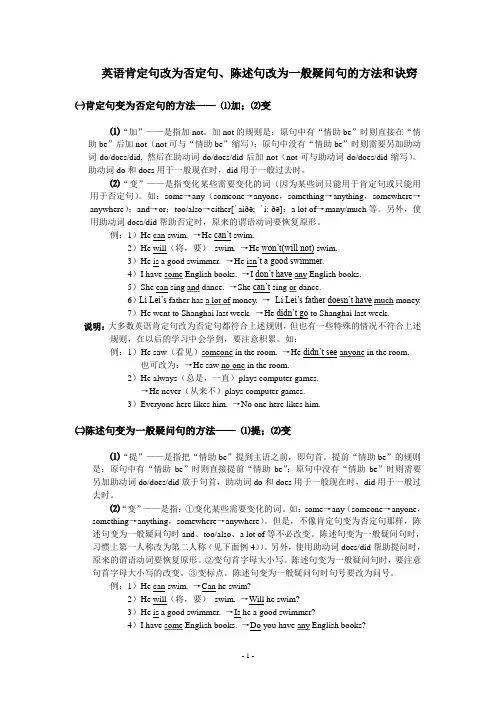
英语肯定句改为否定句、陈述句改为一般疑问句的方法和诀窍㈠肯定句变为否定句的方法——⑴加;⑵变⑴“加”——是指加not。
加not的规则是:原句中有“情助be”时则直接在“情助be”后加not(not可与“情助be”缩写);原句中没有“情助be”时则需要另加助动词do/does/did, 然后在助动词do/does/did后加not(not可与助动词do/does/did缩写)。
助动词do和does用于一般现在时,did用于一般过去时。
⑵“变”——是指变化某些需要变化的词(因为某些词只能用于肯定句或只能用用于否定句)。
如:some→any(someone→anyone,something→anything,somewhere→anywhere);and→or;too/also→either[´aiðə; ´i: ðə];a lot of→many/much等。
另外,使用助动词does/did帮助否定时,原来的谓语动词要恢复原形。
例:1)He can swim. →He can’t swim.2)He will(将,要)swim. →He won’t(will not) swim.3)He is a good swimmer. →He isn’t a good swimmer.4)I have some English books. →I don’t have any English books.5)She can sing and dance. →She can’t sing or dance.6)Li Lei’s father has a lot of money. →Li Lei’s father doesn’t have much money.7)He went to Shanghai last week. →He didn’t go to Shanghai last week.说明:大多数英语肯定句改为否定句都符合上述规则,但也有一些特殊的情况不符合上述规则,在以后的学习中会学到,要注意积累。
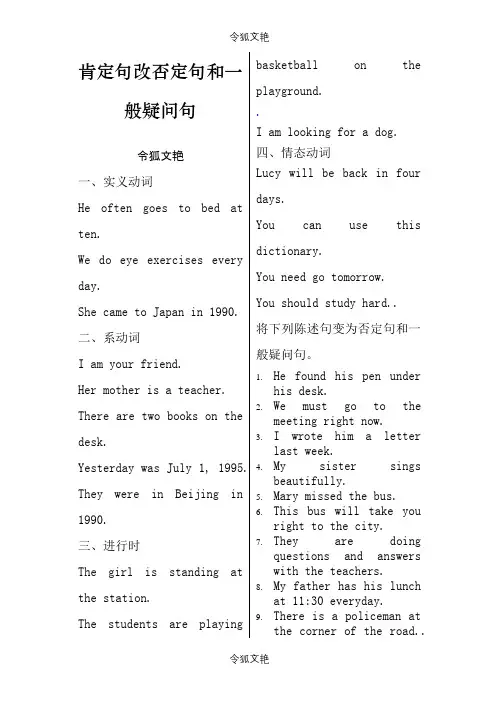
肯定句改否定句和一般疑问句令狐文艳一、实义动词He often goes to bed at ten.We do eye exercises every day.She came to Japan in 1990.二、系动词I am your friend.Her mother is a teacher. There are two books on the desk.Yesterday was July 1, 1995. They were in Beijing in 1990.三、进行时The girl is standing at the station.The students are playing basketball on the playground..I am looking for a dog.四、情态动词Lucy will be back in four days.You can use this dictionary.You need go tomorrow.You should study hard..将下列陈述句变为否定句和一般疑问句。
1.He found his pen underhis desk.2.We must go to themeeting right now.3.I wrote him a letterlast week.4.My sister singsbeautifully.5.Mary missed the bus.6.This bus will take youright to the city.7.They are doingquestions and answerswith the teachers.8.My father has his lunchat 11:30 everyday.9.There is a policeman atthe corner of the road..10.Wang made some modelships for the boys.11.I saw somebody in theroom just now.12.There is some wonderfulnews in today’s paper.13.Xiao Li dropped theletter into the letterbox.14.They are playing on theplayground.15.Tom often tells themstories in French.16.After class somestudents play balls. 17.Mary is readingnewspaper now.18.I telephoned youyesterday.19.You have to go now.20.I have a house in thecountry.21.We did our homeworktogether.22.They study forexamination.23.We are talking aboutthe film.24.I can go to the zootoday.25.The first class beginsat eight o’clock.26.It takes you threehours to go to Paris byair.27.I reviewed my lessonsyesterday.28.I’ll go home by bus.29.He forgot to post theletter this morning. 30.This room is going tobe painted next week.肯定句变否定句和一般疑问句类型答案一、实义动词He often goes to bed at ten.→He does not often go to bed at ten.→Does he often go to bed at ten?We do eye exercises every day.→We don’t do eye exercises every day.→Do you do eye exercises every day?She came to Japan in 1990.→She did not come to Japan in 1990.→Did she come to Japan in 1990?二、系动词I am your friend.→I am not your friend.→Are you my friend?Her mother is a teacher.→Her mother is not a teacher→Is her mother a teacher? There are two books on the desk.→There are not two books on the desk→Are there two books on the desk?Yesterday was July 1, 1995.→Yesterday was not July 1, 1995.→Was yesterday July 1, 1995?They were in Beijing in 1990.→They were not in Beijing in 1990→Were they in Beijing in 1990?三、进行时The girl is standing at the station.→The girl is not standing at the station.→Is the girl standing at the station?The students are playing basketball on the playground.→The students are not playing basketball on the playground.→Are the students playing basketball on the playground?I am looking for a dog.→I am not looking for a dog.→Are you looking for a dog?He was writing letters atthis time last night.→He was not writing letters at this time last night.→Was he writing letters at this time last night? We were having a meetingthis time yesterday.→We were not having a meeting this time yesterday.→Were you having a meeting this time yesterday?四、情态动词Lucy will be back in fourdays.→Lucy will not be back in four days.→Will Lucy be back in four days?You can use thisdictionary.→You can not use thisdictionary.→Can I use this dictionary?You need go tomorrow.→You need not go tomorrow.→Need I go tomorrow?You should study hard.→You should not study hard..→should I study hard?将下列陈述句变为否定句和一般疑问句。
1、You can use this dictionary.(改为否定句)You cannot(can’t)use this dictionary.2、There is some wonderful news in today’s paper.(改为否定句)There are any wonderful news in today’s paper.3、They play football on the playground.(改为一般疑问句,并作肯定回答)Do they play football on the playground?Yes, they do.4、This is my ID card.(改为一般疑问句)Is this your ID card?5、The schoolbag is under the desk.(改为一般疑问句,并作肯定回答)Is the schoolbag under the desk?Yes,it is.一、肯定句改否定句的方法:1、在be动词后加not。
如:is not ,are not ,am not,was not,were not;2、在can,should,will等后加not。
如:cannot,should not,will not;3、上述都没有的,在动词前加助动词否定形式don’t/doesn’t/didn’t。
4、some 改成any。
如:I am a girl. →I am not a girl.You are a student. →You are not a student.→You aren’t a student.This is Tom’s bag, →This is not Tom’s bag.→This isn’t Tom’s bag.答题方法是;否定词no t在be后边。
二、肯定句改一般疑问句的方法:1、把be动词放在句首,剩下的照抄,(some 改成any,I改成you,my改成your,)句点改成问号。
肯定句改否定句和一般疑问句一、实义动词He often goes to bed at ten.We do eye exercises every day.She came to Japan in 1990.二、系动词I am your friend.Her mother is a teacher.There are two books on the desk. Yesterday was July 1, 1995.They were in Beijing in 1990.三、进行时The girl is standing at the station.The students are playing basketball on the playground..I am looking for a dog.四、情态动词Lucy will be back in four days.You can use this dictionary. You need go tomorrow.You should study hard..将下列陈述句变为否定句和一般疑问句。
1.He found his pen under his desk.2.We must go to the meeting right now.3.I wrote him a letter last week.4.My sister sings beautifully.5.Mary missed the bus.6.This bus will take you right to the city.7.They are doing questions and answers with theteachers.8.My father has his lunch at 11:30 everyday.9.There is a policeman at the corner of the road..10.Wang made some model ships for the boys.11.I saw somebody in the room just now.12.There is some wonderful news in today’s paper.13.Xiao Li dropped the letter into the letter box.14.They are playing on the playground.15.Tom often tells them stories in French.16.After class some students play balls.17.Mary is reading newspaper now.18.I telephoned you yesterday.19.You have to go now.20.I have a house in the country.21.We did our homework together.22.They study for examination.23.We are talking about the film.24.I can go to the zoo today. 25.The first class begins at eight o’clock.26.It takes you three hours to go to Paris by air.27.I reviewed my lessons yesterday.28.I’ll go home by bus.29.He forgot to post the letter this morning.30.This room is going to be painted next week.肯定句变否定句和一般疑问句类型答案一、实义动词He often goes to bed at ten.→He does not often go to bed at ten.→Does he often go to bed at ten?We do eye exercises every day.→We don’t do eye exercises every day.→Do you do eye exercises every day?She came to Japan in 1990.→She did not come to Japan in 1990.→Did she come to Japan in 1990?二、系动词I am your friend.→I am not your friend.→Are you my friend?Her mother is a teacher.→Her mother is not a teacher→Is her mother a teacher?There are two books on the desk.→There are not two books on the desk→Are there two books on the desk?Yesterday was July 1, 1995.→Yesterday was not July 1, 1995.→Was yesterday July 1, 1995?They were in Beijing in 1990.→They were not in Beijing in 1990→Were they in Beijing in 1990?三、进行时The girl is standing at the station.→The girl is not standing at the station.→Is the girl standing at the station?The students are playing basketball on the playground.→The students are not playing basketball on the playground.→Are the students playing basketball on the playground?I am looking for a dog.→I am not looking for a dog.→Are you looking for a dog?He was writing letters at this time last night.→He was not writing letters at this time last night.→Was he writing letters at this time last night? We were having a meeting this time yesterday.→We were not having a meeting this time yesterday.→Were you having a meeting this time yesterday?四、情态动词Lucy will be back in four days.→Lucy will not be back in four days.→Will Lucy be back in four days?You can use this dictionary.→You can not use this dictionary.→Can I use this dictionary?You need go tomorrow.→You need not go tomorrow.→Need I go tomorrow?You should study hard.→You should not study hard..→should I study hard?将下列陈述句变为否定句和一般疑问句。
肯定句改否定句和一般疑问句You need go tomorrow.一、实义动词He often goes to bed at ten.You should study hard..We do eye exercises every day.将下列陈述句变为否定句和一般疑问句。
She came to Japan in 1990. He found his pen under his desk. 1.二、系动词We must go to the meeting right now. 2.I am your friend.Her mother is a teacher. I wrote him a letter last week. 3.There are two books on the desk. My sister sings beautifully. 4.Yesterday was July 1, 1995.Mary missed the bus. 5.They were in Beijing in 1990. This bus will take you right to the city. 6.三、进行时The girl is standing at the station.theanswers with are doing questions and 7.Theyteachers.The students are playing basketball on the playground..My father has his lunch at 11:30 everyday. 8.I am looking for a dog. There is a policeman at the corner of the road.. 9. 四、情态动词Lucy will be back in four days.Wang made some model ships for the boys. 10.You can use this dictionary.1 4/I can go to the zoo today. 24.11.I saw somebody in the room just now.clock. The first class begins at eight o '25.There is some wonderful news in today's paper. 12.It takes you three hours to go to Paris by air. 26.Xiao Li dropped the letter into the letter box. 13.I reviewed my lessons yesterday. 27. 14.They are playing on the playground.ll go home by bus. I'28.15.Tom often tells them stories in French.He forgot to post the letter this morning. 29. After class some students play balls. 16. This room is going to be painted next week. 30.Mary is reading newspaper now. 17.I telephoned you yesterday. 18.You have to go now. 19.I have a house in the country. 20.We did our homework together. 21.They study for examination. 22. We are talking about the film. 23.4/ 2Was he writing letters at this time last night? →肯定句变否定句和一般疑问句类型We were having a meeting this time yesterday.答案We were not having a meeting this time yesterday. →一、实义动词Were you having a meeting this time yesterday? →He often goes to bed at ten. 四、情态动词He does not often go to bed at ten. →Lucy will be back in four days. Does he often go to bed at ten? →Lucy will not be back in four days. →We do eye exercises every day. Will Lucy be back in four days? →→We don't do eye exercises every day.You can use this dictionary. Do you do eye exercises every day? →You can not use this dictionary. →She came to Japan in 1990.Can I use this dictionary? →She did not come to Japan in 1990. →You need go tomorrow. Did she come to Japan in 1990? →You need not go tomorrow. →二、系动词Need I go tomorrow? →I am your friend. You should study hard. I am not your friend. →.→You should not study hard.Are you my friend? →? should I study hard→Her mother is a teacher. Her mother is not a teacher →将下列陈述句变为否定句和一般疑问句。
三年级英语句型转换方法归纳三年级英语句型转换方法主要包括以下几种:1. 肯定句改否定句的方法:在be动词后加not,没有be动词则加助动词。
肯定句中有some,否定句中将其改为any。
肯定句中有and,否定句中用or替换。
2. 陈述句变一般疑问句的方法:将be动词/助动词提前,首字母大写。
疑问词+be动词/助动词+主语+其他?3. 陈述句变特殊疑问句的方法:先找出be动词或助动词,将其提前,再确定疑问词。
疑问词+be动词/助动词+主语+其他?4. “have”变“there be”结构:there be表示“存在”,have表示“拥有”。
there be +名词+地点,表示某地有某物。
5. 时态的转换:现在进行时:be+动词ing形式,表示正在进行的动作。
一般现在时:动词原形或第三人称单数形式,表示经常发生的动作或存在的状态。
一般过去时:动词过去式,表示过去发生的动作或存在的状态。
6. 人称代词的转换:主格:I(我)、you(你)、he(他)、she(她)、it(它)、we(我们)、you(你们)、they(他们)。
宾格:me(我)、you(你)、him(他)、her(她)、it(它)、us (我们)、you(你们)、them(他们)。
7. 地点介词的转换:in表示在某一范围内或在某物的里面。
on表示与某物接触或在某物的上方。
under表示在某物的下方。
near表示在某物的附近。
next to表示紧挨着某物。
8. 常用短语和表达的转换:Good morning!早上好!Good afternoon!下午好!Good night!晚安!9. 形容词和副词的比较级和最高级的转换:比较级在形容词后加-er,最高级在形容词后加-est。
一些特殊形式的比较级和最高级,如well(更好地),better(最好的),best(最好的)。
10. 特殊疑问词的转换:what什么,对物品的名称进行提问。
where哪里,对地点进行提问。